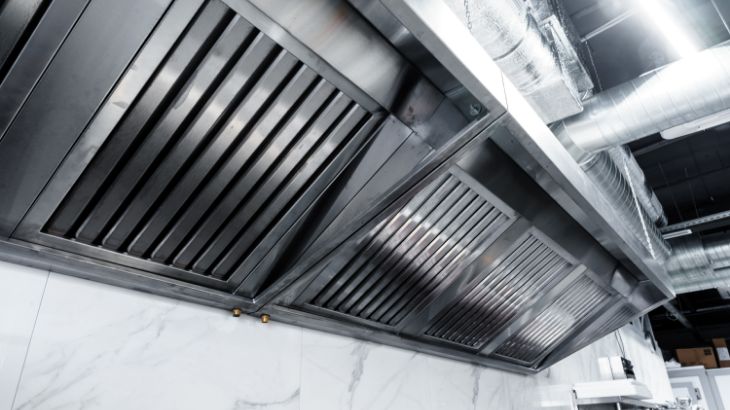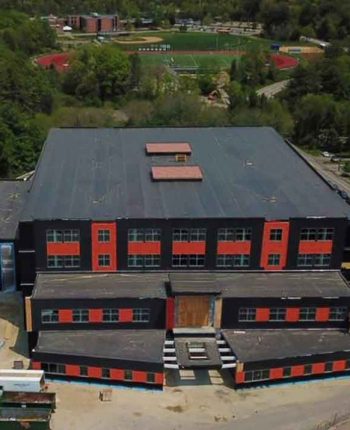
Key Points
- Kitchen ventilation is critical to food service operations, but uses a substantial amount of energy.
- A well-maintained ventilation system can save energy, as well as increase safety and comfort.
- Balancing makeup air and proper equipment placement helps increase ventilation system performance.
Food service facilities use far more energy per square foot of building space than the typical commercial building. The kitchen ventilation system, while critical to food service operations, is a key contributor to that high energy use. These systems remove heat, smoke, grease, and carbon monoxide, as well as steam from cooking and dish washing. A poorly maintained ventilation system not only wastes energy, it reduces safety, as well as worker comfort and productivity.
Understanding how a kitchen ventilation system works is important when taking steps to increase energy efficiency and improve system performance. For handling kitchen effluents, a basic ventilation system consists of a hood or canopy, ductwork, and a fan.
The Hood
The hood captures the plume of heated air (including gaseous, liquid, and solid contaminants) that rises from the cooking surface. A key component is the grease filtering system, typically based on one or more of the following technologies:
- Mesh filters—consist of layers of metal mesh, which trap grease and contaminant particles as air is drawn through. They are not effective at removing high levels of grease, and must be cleaned frequently.
- Baffle filters—separate grease from an air stream by changing air speed and direction. They are more efficient than mesh filters and can be cleaned in dishwashing machines.
- Cartridge filters—are suitable for moderate to heavy grease environments. These stainless steel filters can be cleaned in commercial kitchen dishwashers.
- Water wash—cleans the cartridges in an automatic internal washing cycle. They require a direct hot water supply and are typically costly to install.
- Continuous water mist—is a very effective grease removal system. It uses a continuous mist of cold water sprayed into the extraction system. Fats are emulsified and dropped into a collection trough.
- Ultraviolet (UV)—is a recently developed technology, which integrates UV lights into the hood. The light breaks down grease molecules into smaller compounds of carbon dioxide and water vapor and carries them out through the exhaust airflow.
The Exhaust Fan
The three types of exhaust fans typically found in commercial kitchens include the following:
- Upblast. Upblast fans are the aluminum mushroom-shaped fans commonly seen on restaurant roofs. They are designed to emit kitchen exhaust away from the roof. Direct drive is a recent innovation in which there is no drive belt to wear out. Direct-drive fans can also save energy by running at variable speeds.
- Utility sets. Due to their steel construction, these roofmounted units are capable of handling large volumes of air as well as high temperatures. They are easy to clean, helping to reduce maintenance costs and increase equipment life.
- Inline. These axial fans—rarely used in food service settings—do have some application in minimal grease environments.
Ductwork
Ductwork for cooking exhaust systems is typically fabricated from 16- or 18-gage stainless steel. It should be liquid tight, designed with easy access for cleaning, and routed vertically to the roof as much as possible with minimal turns.
Improving Kitchen Ventilation Efficiency
These simple steps will save energy and help maintain a safe and comfortable kitchen environment:
- Make sure the right amount of makeup air is introduced into the kitchen to compensate for the air taken out by the ventilation system. Ventilation systems work less efficiently with too much or too little makeup air. Integrate your kitchen ventilation units with the building heating, ventilating, and air -conditioning (HVAC) system, bringing in air from adjacent work or serving areas.
- Minimize makeup air velocity near the canopy or hood; it should be at no more than 75 feet per minute.
- If your kitchen has a variety of cooking appliances or a variable schedule, consider using exhaust fans that can accommodate adjustable speed controls.
- Arrange cooking appliances based on how much effluent they produce. Specify different ventilation rates accordingly. For heavy effluent producers, such as char broilers, position the appliance in the center of a hood section, rather than at the end.
- Be sure access panels are properly installed and sealed, and that all sections of ductwork are accessible for cleaning.
If you’re wondering if an electric heat pump could be the right fit for your business, here are five reasons why the answer is “yes.”
- Improved air quality
- Lower operating costs
- A quieter workspace
- A more controlled environment
- A smaller carbon footprint
Through the NHSaves program for new equipment and construction for businesses and towns, the New Hampshire utilities are able to help businesses throughout the state complete major energy efficiency upgrades through guidance and financial incentives.
New equipment and construction incentives are offered to any commercial or industrial customer building a new facility, undergoing a major renovation, or replacing failed (end-of-life) equipment.
The benefits include:
Improved air quality. Electric heat pumps eliminate fumes created by other forms of heating while filtering and circulating the air in a building to create a healthier environment, which is more important than ever.
Lower operating costs. According to the U.S. Office of Energy Efficiency & Renewable Energy, heat pumps can produce one-and-a-half to three times more heat energy than the electricity they use. That kind of efficiency translates into savings of hundreds, if not thousands, of dollars a year on heating and cooling.
A quieter workspace. The jarring sound of a furnace turning on or the shaking of pipes coming through an oil- or coal-fired heating system can be an unwanted disruption in the workplace. According to a report by Evergreen Energy, the noise levels in decibels of a heat pump are 42, slightly higher than the sound inside a library (40), and considerably lower than a dishwasher’s sound (80).
A more controlled environment. Heat pumps allow for quick and easy temperature control for both heating and cooling. That’s because a heat pump system not only brings warm air into a space to provide heat, but also takes it out and replaces it with cooler air during warmer months.
A smaller carbon footprint. Here’s a concise primer from the New Hampshire Electric Cooperative on why heat pumps are eco-friendly: “Utilizing heat pumps reduces fossil fuel consumption. As the heat pump does not burn anything at the heat energy source, there are no additional carbon emissions other than the small amount of electrical energy required to run the compressor.”
By working with the New Hampshire utilities to install new heating and cooling equipment or upgrade your current system, your business is eligible for cost-saving rebates. In addition to rebates, the New Equipment & Construction program offers technical assistance to help customers identify and purchase premium energy-efficient equipment and measures.
The process is simple:
- Contact your local utility for an application and assistance.
- We will review your proposal and estimate your rebate amount or make you a rebate offer to install certain energy-efficient equipment.
- The actual rebate amount is based on the final product installed.
- Enjoy a healthier and more efficient heating and cooling system that is better for the environment.


